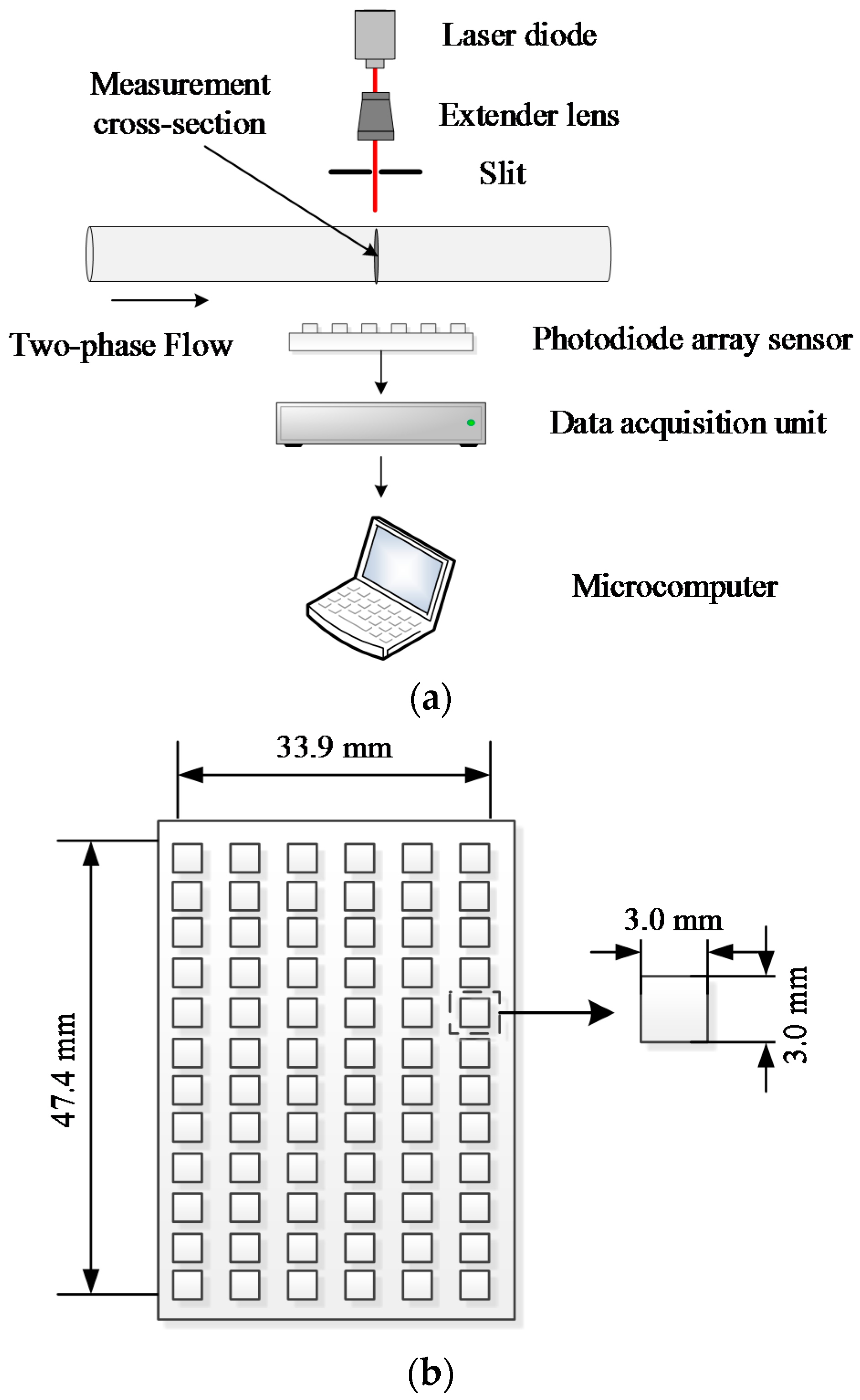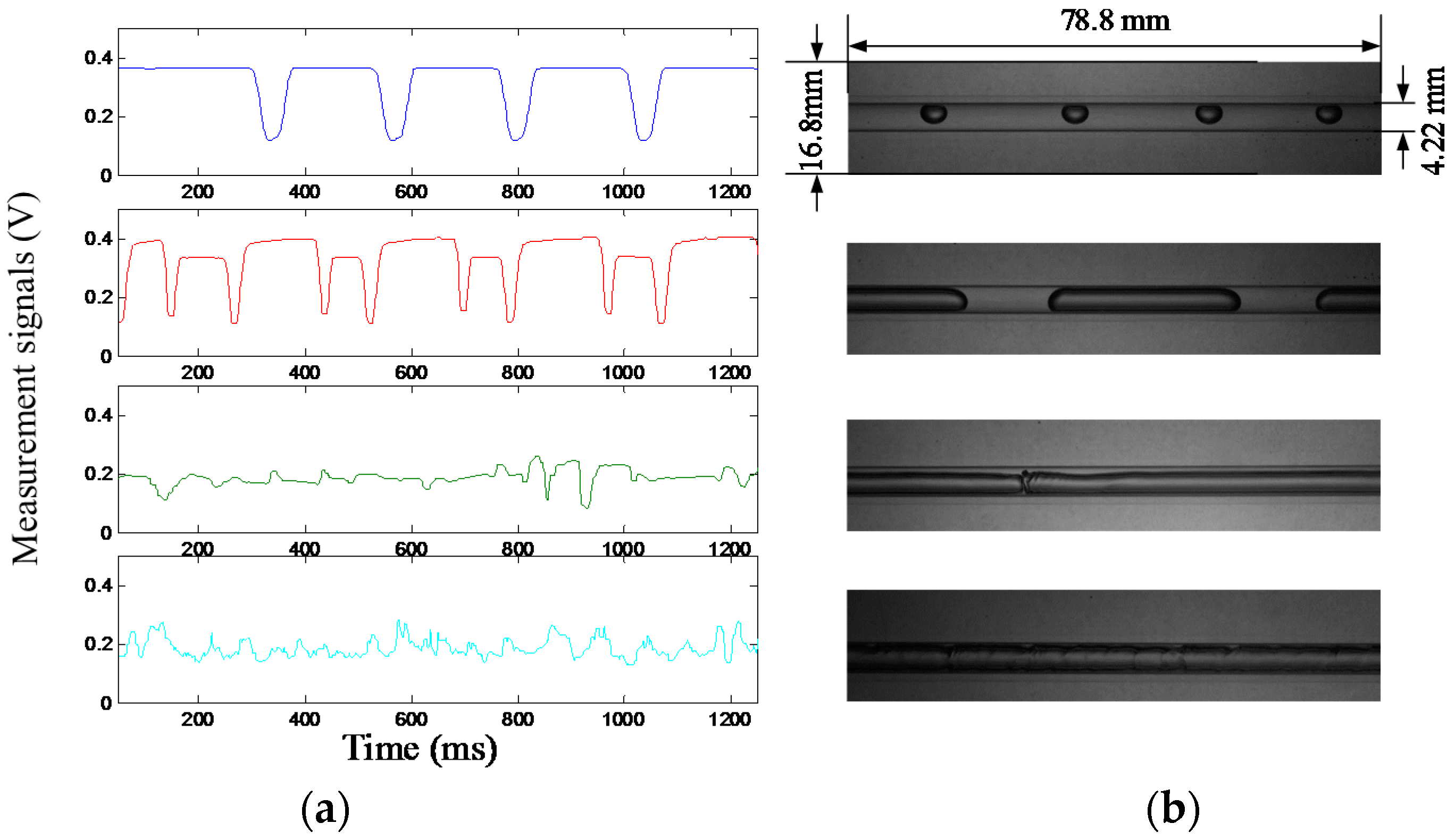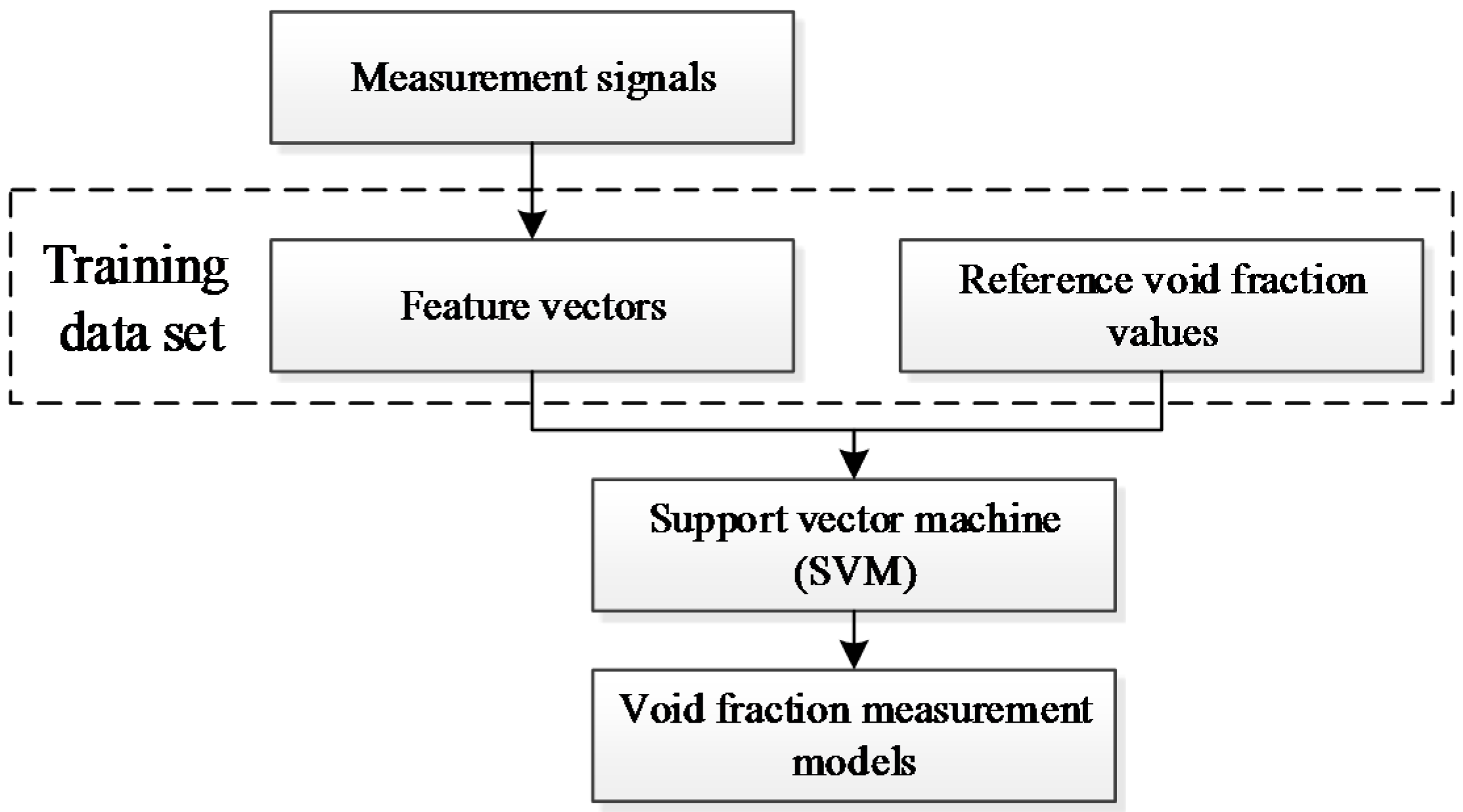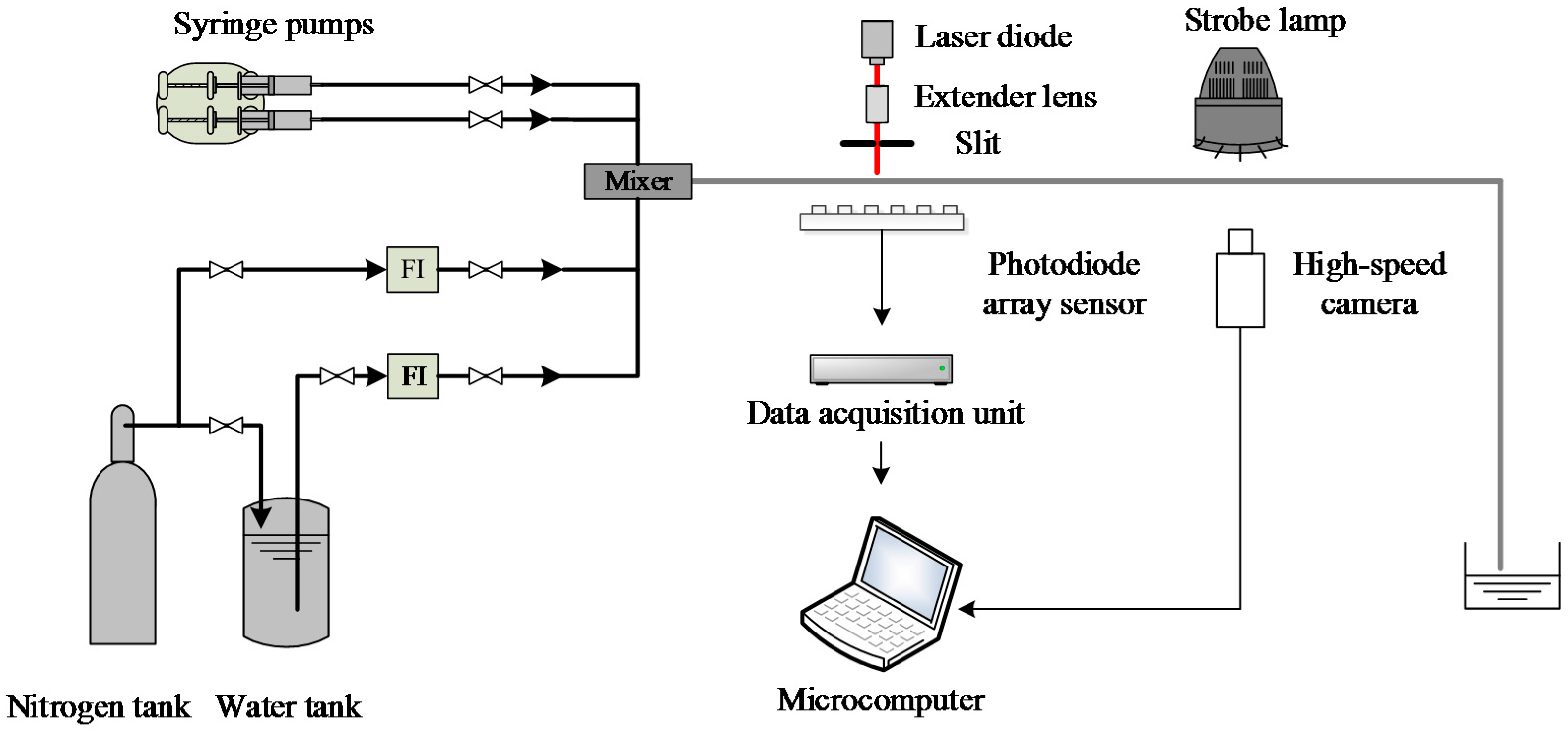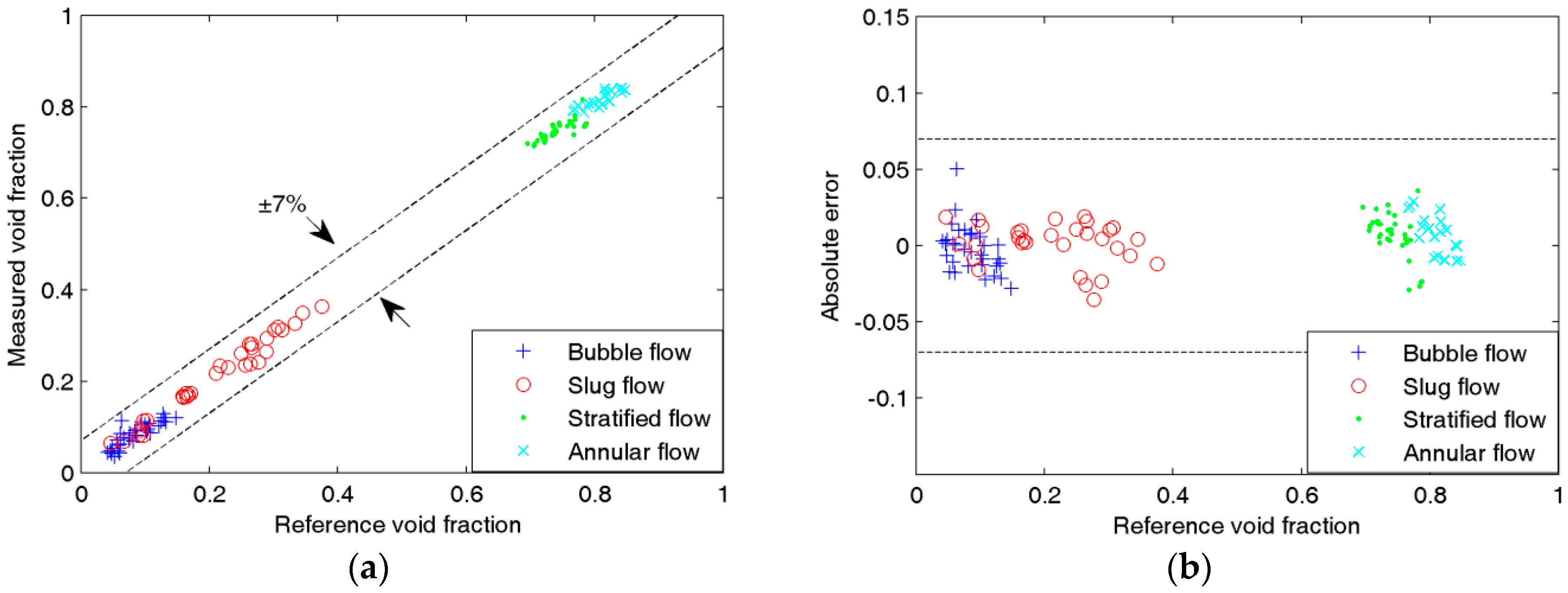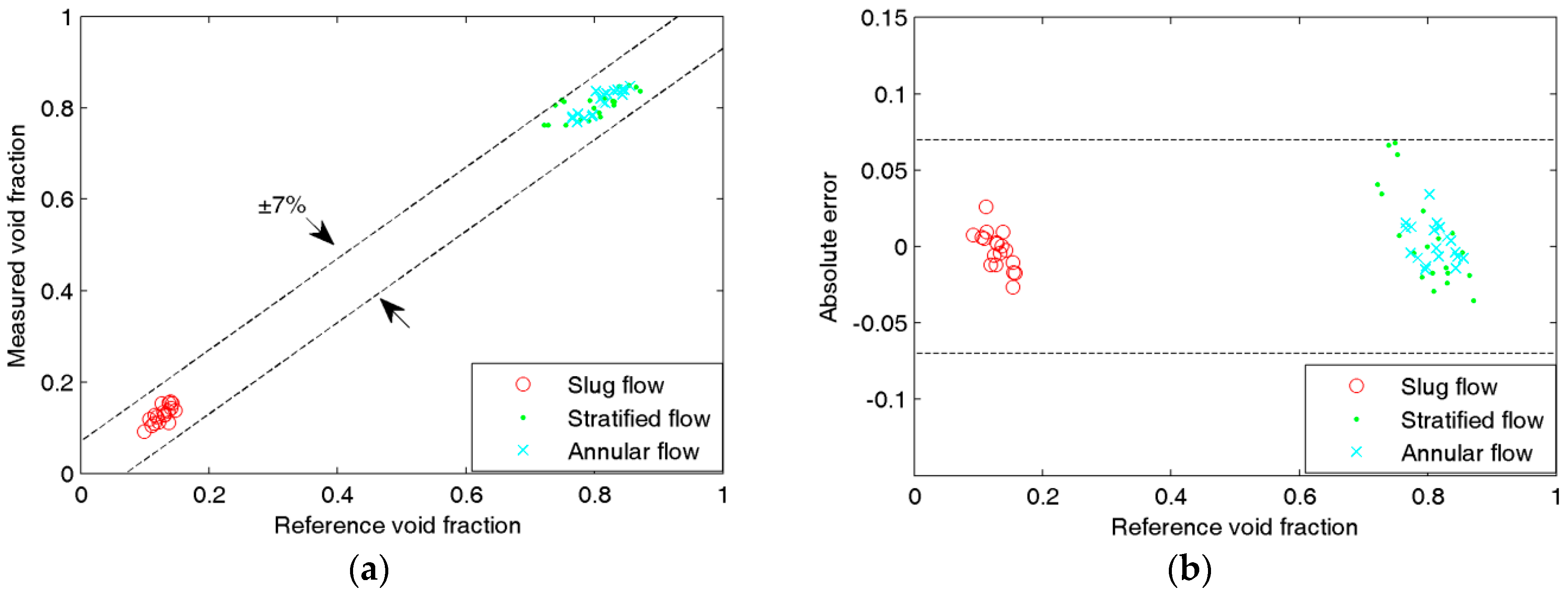1. Introduction
In the past decades, the studies and industrial applications of gas-liquid two-phase flow in small-channel systems, such as chemical reactors, heat exchangers, refrigeration processes and micro-evaporators
etc., have become a significant area [
1,
2,
3]. Void fraction is an important parameter of the two-phase flow. Its on-line measurement is of great importance for the heat and mass transfer efficiency, the estimation of pressure drop, the process control and the measurement of other parameters of the two-phase flow [
4,
5,
6,
7,
8,
9]. However, with the decrease of the channel dimension, the measurement of the void fraction becomes more and more difficult. The conventional measurement methods cannot fulfill the growing requirements of the industrial applications and the mechanism studies of the two-phase flow [
1,
2,
3,
4,
5,
6,
7,
8,
9].
Due to its advantages of high spatial and temporal resolution, the optical measurement technique is a very attractive and useful approach to implement the parameter measurement of gas-liquid two-phase flow in small channels [
10,
11,
12]. The conventional optical measurement methods can be mainly divided into three categories: optical probe method, visualization method, and laser-based method [
10,
11,
12]. Because the optical probe is directly in contact with the detected fluid, the optical probe method will more or less disturb the practical flow of the fluid. In addition, the probes may be contaminated and unpredictable measurement error will arise [
13,
14,
15]. The visualization method includes high-speed cameras, digital cameras, and optical tomography
etc. [
16,
17,
18]. Although the measurement performance of the visualization method is satisfactory, the visualization method has the disadvantages of high cost, complicated construction and higher requirement of the measurement environment [
16,
17,
18]. Many laser-based methods have been proposed and widely studied, including laser Doppler velocimetry, laser induced fluorescence and particle image velocimetry,
etc. However, the conventional laser based methods need an expensive laser source (e.g., Nd–Yag laser source or He-Ne laser source.) and a complicated measurement system (including seeding particle, fluorescent particle and objective lens,
etc.) [
19,
20,
21]. These methods also have the disadvantages of high cost and higher requirements of the measurement environment. Therefore, although significant technical achievements and progresses have been obtained, due to the above mentioned disadvantages, more research works should be undertaken to seek a more effective optical method to implement the parameter measurement of gas-liquid two-phase flow in small channels with the advantages of lower cost, simpler construction and better capability of the environment [
10,
11,
12].
Currently, the techniques of information science and micro-electronics have been rapidly developed. As a new photo-electric device, the performance of photodiode sensor has been significantly improved. The dimension of photodiode sensing element has been greatly decreased and a photodiode array sensor can be successfully developed with much lower cost/price [
22,
23]. As a new kind of laser source, in some cases, the laser diode can be used as a low-cost alternative of the conventional expensive laser source [
24,
25]. These technical progresses have laid a solid foundation of developing a low-cost optical measurement system. Meanwhile, as a newly emerging signal processing technology, machine learning, which aims to implement data mining, pattern recognition and modeling,
etc., has been widely applied and studied in many research fields. Machine learning technology can provide useful approaches to make full use of the measurement information and hence to implement the parameter measurement successfully [
26,
27,
28,
29]. However, up to date, our knowledge and experience on the applications of the above new devices and machine learning technology to the parameter measurement of gas-liquid two-phase flow in small channels are very limited [
4,
5,
6,
7,
8,
9].
Based on a photodiode array sensor and a laser diode, this work aims to develop a low-cost void fraction measurement system and hence to propose a new optical measurement method for the void fraction measurement of gas-liquid two-phase flow in small channels by using machine learning technology.
2. Void Fraction Measurement System and Measurement Scheme
Figure 1a shows the structure of the new void fraction optical measurement system, including a laser diode, an extender lens, a slit, a photodiode array sensor, a data acquisition unit and a microcomputer. The laser diode which is used to produce a beam of laser is YuanDa laser L63510P5 with a wavelength of 635 nm (the wavelength of the laser diode is chosen according to our experience and previous experimental results) and an output power of 5 mW. The extender lens and the slit are used to change the laser into a parallel laser sheet (The extender is used to extend the beam diameter and decrease the laser’s divergence. In this work, the resulting laser through the extender lens has a diameter of 40 mm). The laser sheet passes through the transparent channel perpendicularly, and is absorbed, reflected or deflected by the gas-liquid two-phase flow inside the small channel. The exit laser, which contains the characteristic information of the two-phase flow, is recorded by the array sensor. The output signals of the array sensor are then transmitted to the microcomputer by the data acquisition unit.
Figure 1b illustrates the layout of the photodiode array sensor. According to the required sensing area, the cost and the size of the sensing element, the array sensor consists of 72 (12 × 6) sensing elements. The outputs of the 72 sensing elements will be sent into the micropucter simultaneously. The sensing element is Vishay Telefunken PIN photodiode BPW34, which has a sensing area of 3.0 × 3.0 mm
2 (in this work, the Signal to Noise Ratio of the sensing element is about 30 dB). Meanwhile, it is necessary to indicate that the number of the sensing elements is determined by our previous experimental results. It is not an optimal number. To look for an optimal element number of the array sensor will be our further research.
Figure 1.
(a) The structure of the new void fraction optical measurement system; (b) The layout of the photodiode array sensor.
Figure 1.
(a) The structure of the new void fraction optical measurement system; (b) The layout of the photodiode array sensor.
Research works have verified that the flow patterns of gas-liquid two-phase flow have significant influences on the measurement of the void fraction [
1,
2,
3,
4,
5,
6,
30]. If we use one measurement model for the void fraction measurment, the measurement accuracies will not be satisfactory. An effective approach to solve this problem is to develop different measurement models for different flow patterns. Thus, the real time flow pattern identification result is necessary and the identification result is introduced to the void fraction measurment. In this work, the real-time flow pattern identification result is introduced into the void fraction measurement process. Meanwhile, for each typical flow pattern, a specific void fraction measurement model is developed.
Figure 2 shows the scheme of the void fraction measurement. With the obtained measurement signals (a total of 72 groups of optical signals obtained by the array sensor), a feature vector is firstly extracted. According to the feature vector, the real-time flow pattern identification is then implemented. Finally, according to the flow pattern identification result, a relevant void fraction measurement model is selected to calculate the void fraction.
Figure 2.
The scheme of the void fraction measurement.
Figure 2.
The scheme of the void fraction measurement.
To obtain the comprehensive information of the two-phase flow, the feature vector is extracted from the 72 measurement signals obtained by the photodiode array sensor (each measurement signal is obtained by one sensing element and contains a series of data points). The feature vector consists of two groups of statistical features which contain useful information of the gas-liquid two-phase flow, the mean values and the standard deviations of the 72 measurement signals.
The mean value represents the time-averaged characteristic of a measurement signal. The mean value of the measurement signal obtained by the
kth sensing element
mk is
where
L is the data length of the measurement signal,
uk is the measurement signal obtained by the
kth sensing element, and
k = 1,2,3,…,72.
The standard deviation represents the dispersion of a measurement signal. The standard deviation of the measurement signal obtained by the
kth sensing element
dk is
Thus, combining the two groups of statistical features, the feature vector
x is obtained
The flow pattern identification is a pattern recognition problem. The development of a void fraction measurement model is a modeling problem. As mentioned in
Section 1, machine learning technology can provide many useful approaches to solve pattern recognition problems or modeling problems, such as
k-nearest neighbor, linear discriminant analysis, and Bayes classifier,
etc. can implement the pattern recognition [
26,
27,
28,
29], while linear regression, artificial neural network and Bayesian learning,
etc. can implement the modeling [
26,
27,
28,
29].
Compared with the other pattern recognition techniques mentioned above, Fisher Discriminant Analysis (FDA) is a dimensionality reduction technique and can provide a linear transformation that maximizes the between-class scatter and minimizes the within-class scatter. FDA has been widely used in the pattern identification field, and its effectiveness has been verified [
26,
27,
28,
29,
31,
32]. Thus, in this work, FDA is adopted to implement the flow pattern identification. Compared with the other modeling techniques mentioned above, Support Vector Machine (SVM) is a valid machine-learning technique and is suitable for model developing in small sample conditions. SVM has good generalization ability and has been widely used in many fields for model development [
26,
27,
28,
29,
33]. Therefore, in this work, SVM is selected to develop the void fraction measurement models.
3. Flow Pattern Identification
Four typical flow patterns of gas-liquid two-phase flow in small channels are investigated in this work, including bubble flow, slug flow, stratified flow, and annular flow. According to our experimental results, the measurement signals of the bubble flow and the slug flow have some similarities, while the measurement signals of the stratified flow and the annular flow have some similarities.
Figure 3 shows typical groups of the measurement signals and the images of the four flow patterns. The measurement signals are obtained by a sensing element (
i.e., the sixth BPW34 diode at the fourth column of the photodiode array sensor). The images of the flow patterns are obtained by a high-speed camera (Intergrated Design Tools, Inc. (IDT) Redlake MotionXtra N-4).
As shown in
Figure 3, in the bubble flow, when a gas bubble passes through the measurement cross-section, the measurement signal has a clear voltage decrease and stays steady when the channel is full of water. In the slug flow, the measurement signal also has clear voltage decrease when a gas slug approaches and leaves, while at the central part of the gas slug, the measurement signal remains invariable. The measurement signals of the bubble flow and the slug flow have some similarities, but the voltage decrease amplitudes of the signals are different. In the annular flow or the stratified flow, the measurement signals both display fluctuations. However, the amplitude of the measurement signal fluctuation in the annular flow is different from that in the stratified flow. Therefore, based on the above characteristics of the measurement signals in different flow patterns, in this work, the bubble flow and the slug flow are initially classified as one group (Group 1), and the stratified flow and the annular flow are initially classified as the other group (Group 2).
Figure 4 shows the flowchart of the flow pattern identification. The process of the flow pattern identification has two key steps. The first step is to determine that the real-time flow pattern belongs to Group 1 or Group 2 by Classifier A. The second step is to determine the specific real-time flow pattern by Classifier B or C.
Figure 3.
(a) Measurement signals of the four flow patterns obtained by one sensing element; (b) Images of the four flow patterns obtained by a high-speed camera.
Figure 3.
(a) Measurement signals of the four flow patterns obtained by one sensing element; (b) Images of the four flow patterns obtained by a high-speed camera.
Figure 4.
The flowchart of the flow pattern identification.
Figure 4.
The flowchart of the flow pattern identification.
The three classifiers (Classifier A, B, and C) are developed by FDA and each classifier is aimed to solve a binary classification problem. The decision function of the binary classifier can be expressed as:
where
y is the class label (
y = −1 or 1),
x is the feature vector,
ω is the Fisher vector and
ω0 is the threshold.
ω can be determined by solving the following problem:
where
Sw is the within-class-scatter matrix and
Sb is the between-class-scatter matrix. Once the classifier is developed, by inputting the feature vector
x into the decision function, the identification result can be obtained according to the class label
y. The detailed description concerning FDA is available in [
26,
27,
28,
29].
4. Void Fraction Measurement Model Development
Figure 5 shows the flowchart of the void fraction measurement model development. For each typical flow pattern, a specific void fraction measurement model is developed. According to experimental results, a training data set is constructed. The training data set includes the sample feature vectors extracted from the experimental measurement signals and the reference void fraction values. With the training data set, the void fraction measurement models of the four flow patterns (totally four models) are developed by SVM.
Figure 5.
The flowchart of the void fraction measurement model development.
Figure 5.
The flowchart of the void fraction measurement model development.
According to the principle of SVM, the void fraction measurement model can be expressed as:
where
α is the void fraction,
x is the feature vector, and
is the training data set with
p samples.
K(x,xi) is kernel function. In this work, the radial basis function
is selected as the kernel function, and
σ is its diameter.
b is a parameter.
βi and
βi* are the Lagrange multipliers, which are determined by solving the following optimization problem:
where
ε is the slack variable and
C is the penalty factor. The detailed description concerning the SVM is available in [
27,
28,
29].
8. Conclusions
In this work, based on a photodiode array sensor and a laser diode, a low-cost and simple-structure void fraction measurement system for gas-liquid two-phase flow in small channels is developed. A low-cost laser diode is adopted as the laser source and a 12 × 6 photodiode array sensor is used to obtain the information concerning the two-phase flow. Meanwhile, a new void fraction measurement method is proposed. The machine learning techniques (FDA and SVM) are adopted to implement the flow pattern identification and the development of the void fraction models. To overcome the influence of flow pattern on the void fraction measurement, the identification result is introduced to the void fraction measurement. Then, according to the identification result, a relevant void fraction measurement model is selected to implement the void fraction measurement.
Experiments are carried out in four small channels with different inner diameters of 4.22, 3.04, 2.16 and 1.08-mm, respectively. Four typical flow patterns including bubble flow, slug flow, stratified flow and annular flow are investigated. The maximum absolute error of the void fraction measurement is less than 7%. The experimental results show that the proposed void fraction measurement method is effective and the development of the measurement system is successful. The experimental results also show that the introduction of the flow pattern information can overcome the influence of the flow pattern on the void fraction measurement.
The research results also verify that the low-cost laser diode can act as a competent replacement of the expensive standard laser source if suitable signal processing techniques and information acquisition techniques are used. That can significantly reduce the cost of the laser based measurement system. This research work can provide a good reference for other researchers’ works.
